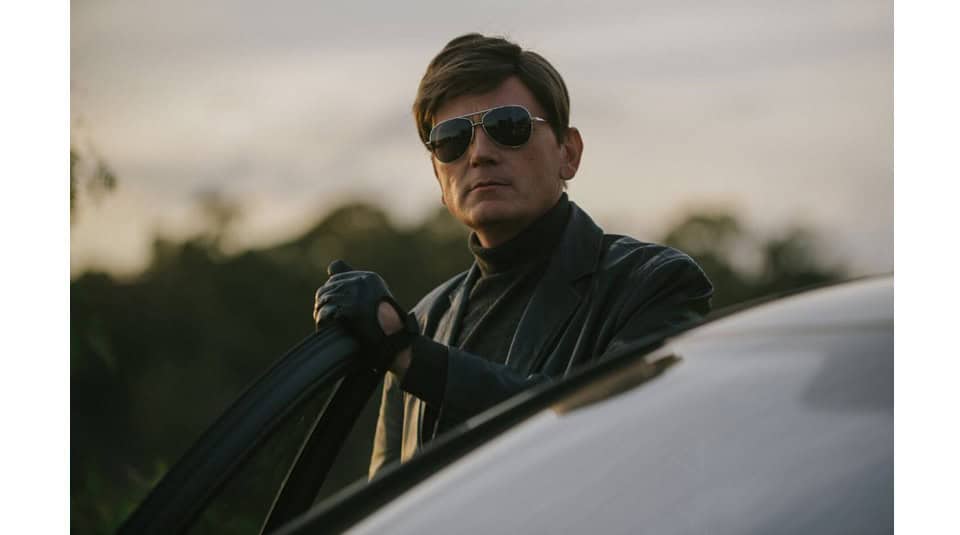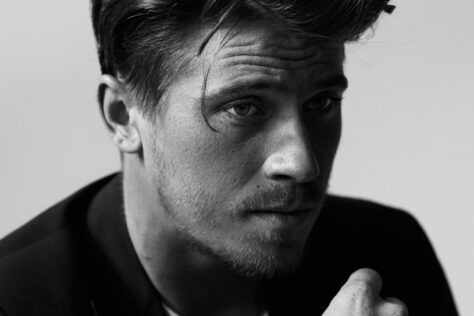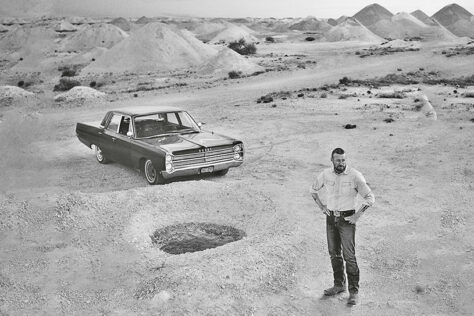I've always been obsessed with people wearing bad hairpieces where everyone has to pretend like it's real and no one can say anything about it.
You have to give the guy credit: Pat Healy knows how to grab people. In Craig Zobel’s Sundance breakout Compliance (2012), the actor played a sinister prank caller who triggers a series of disturbing incidents at a fast food joint. In Paul Thomas Anderson’s Magnolia (1999), he played the object of Julianne Moore’s irritation—the receiving end of her explosive, expletive-ridden tirade. There are many standouts in his body of work: Terry Zwigoff’s Ghost World (2001), Ti West’s The Innkeepers (2011), and Werner Herzog’s criminally underrated Rescue Dawn (2006).
Take Me is Healy’s feature directorial debut that threads the needle between crime thriller and slapstick farce. Healy also stars as Ray Moody, who operates Kidnap Solutions, a single-employee enterprise specializing in “fully immersive exposure therapy”—as advertised on this very ugly and prehistoric website—that’s known to remedy all sorts of addictions. Wink, ring a bell? A spade a spade: this is a simulated high-stakes kidnapping operation, an understandably threadbare market, with curative aims and/or amusement, be it fetishistic or otherwise. For instance, Ray kidnaps a compulsive overeater (Parks and Recreation’s Jim O’Heir) in the film’s opening moments, ties him up, berates him, and force-feeds his willing abductee giant and sloppy cheeseburgers. In theory, this should scare the fat guy thin. When a mysterious caller (Taylor Schilling) contracts Ray for a particularly questionable weekend-long simulation that demands she be slapped around, he can’t seem to look past the dollar signs and breaks protocol, and quickly finds himself in dire straits.
Take Me, written by Mike Makowsky, marks an exciting new chapter for the actor-turned-director. It’s worth noting that Healy authored a dozen feature screenplays of his own over the years, including Strange Skies and Snow Ponies, both landing spots on Hollywood’s coveted The Black List in 2006 and 2007 respectively. The latter script is currently in pre-production with Gerard Butler attached to star. Take Me world premiered at the Tribeca Film Festival last month.
Take Me hits theaters and VOD on May 5th, and worldwide streaming by Netflix later this year.
Hi, Pat. Congratulations on Take Me. I saw it yesterday and I thought it was a lot of fun.
Oh, thanks. It’s supposed to be a funny movie, so I like to hear that it works when people watch it alone, you know what I mean? Sometimes with a comedy I’ll see it with an audience, and I’m glad that you and other people are liking it, even if they end up watching it at home or whatever.
The first question that I had was whether Take Me could be something Mike Makowsky plucked from reality. I know Craig Zobel’s Compliance was based on true events, which is weird to think about. It’s certainly not a stretch to imagine Kidnap Solutions could exist.
I don’t know where he got the idea from, but I do know that he’s very interested in immersive theater and things like Blackout. He’s just very interested in role-playing. We did a thing with this movie where we had the actual Kidnap Solutions website. Before we announced the movie, they sent out a press release about Kidnap Solutions and people wrote in and Mike answered all of the emails as me—my character, rather. He likes that. For me, I just thought it was really novel because I had never heard of that. Immediately off the bat, it’s a really creative idea because it’s sort of like inventing a job that doesn’t exist, right? If you start with that original premise and then take it to these crazy places, where there are two or three major turns you don’t see coming—it’s just so rare to find a script like that. To start with something so original and then just keep subverting our expectations and twisting genres like that is what really drew me in. And you can see where something could go terribly wrong… That’s a ripe premise for a movie, a comedy especially because the highest of comedy comes from all the confusion in these two people role-playing. It’s like two people working off different scripts, not knowing that they’re actually in the same movie.
When you first read the material, did the look of your character come to you right away? I mean, how many wigs do you try on before arriving at the one you know is right?
He didn’t wear a wig in the script. What happened was that, one of the first things I always think about is hair and I thought this guy should have funny hair. There’s just something a little dopey about him. I was having a conversation with Mark Duplass and Taylor [Schilling] where she was going to wear a wig, too, because she was originally supposed to be coming off Orange Is the New Black and her hair was all fried out. We wanted her to have the long, luxurious blond locks. So she was going to wear a wig, I was going to wear a wig, but pretend that mine is real. In other words, it would be the character’s actual hair that makes him dopey. Once Mark heard that, we started to talk about how this movie is sort of about actors. At the very least, it’s subtextually about actors. Both Taylor and I obviously know what it’s like to be actors and all the things we go through.
Since we were both going to wear wigs now, Mark suggested, “Maybe it’s revealed in the movie that you’re both wearing wigs.” That idea stuck with me. For Taylor, not so much. And she ended up doing another movie first and had the hair anyway. She no longer needed the wig. Then I started working with this really amazing wigmaker named Stacy Schneiderman. I just started talking about things like this old screwball comedy by Howard Hawks called Twentieth Century with John Barrymore where his hair is pretty cool, but when he goes crazy, it just goes all over the place. Gene Wilder modeled his hair in Young Frankenstein after John Barrymore in that movie. There’s this Burt Reynolds movie called Malone from the ’80s where he’s like this much older guy, but wearing this thing that doesn’t belong on his head—you can see the seam on the back of it. I just kept giving [Stacy] different references and ideas and photos and things, and she came up with that wig. I didn’t see the wig fully coiffed and designed as you see in the film until I put it on the first day. Then I suddenly knew. Sometimes they say you know when you put on the right shoes or the right clothes. I put that wig on and it was like, “Okay, I know exactly what this is now.”
There’s no mistaking when you see the first shot that it’s supposed to be funny, you know? You should laugh. Not that this is a total comedy, but it’s okay to laugh right away. Then a problem we ran into early on when we were screening it for our friends—mostly other independent filmmakers—is that, since it isn’t revealed to be an actual wig until later, they just thought we had a cheap hair budget. They didn’t realize that I also knew it looked bad. I’ve always been obsessed with people wearing bad hairpieces where everyone has to pretend like it’s real and no one can say anything about it. It also said a lot about the character and his insecurities: the wig, the jacket, the gloves, the sunglasses… He wears lifts. He has spray tan. I don’t talk about it in the movie, but I do sort of strip away these layers. So that idea wasn’t in the script and it came later. It came from Mark, and I ran with it. It became, I think, really central to one of the things that the movie was about.
Take Me is equal parts crime thriller and slapstick farce. Was that difficult to calibrate?
Yes. There’s a whole genre of screwball comedy and film noir, which most people don’t know today, and it’s just there with film scholars. They’re sort of related in a way. They’re usually both about some schlub who gets led down some kind of rabbit hole by a woman, usually a blond, who is very alluring but crazy in some way. The noir tends to end tragically and the screwball usually ends with a wedding, or something like that. In the ’80s, there were movies like After Hours by [Martin] Scorsese and Into the Night by John Landis and Something Wild directed by Jonathan Demme. Those were all really, really important movies to me as a teenager. They have qualities of both the screwball and the noir. It took us a long time in post to get it just right because people wouldn’t know whether they’re supposed to be laughing. It was really a lot about the music that Heather McIntosh did, which is the last piece of the puzzle. She really nailed the tone of it and I think that sells/blends it a lot easier. It did take a really long time to get it just right, though.
This is your feature directorial debut, which marks a big chapter. How did you find the experience being on the other side of the camera directing yourself and your co-stars?
I found it very easy prepping and shooting the movie, and almost impossible and unbearable in post. Going into a room every day and looking at myself on the screen—I’m just not that in love with myself or the way I look. That was sort of masochistic on my part. I didn’t have a lot of forethought as to what that would be like. I keep referencing Albert Brooks, who was also a big influence on me, and Defending Your Life, where he goes to Judgment City. You sit in a room every day and watch clips of all the mistakes you made and have other people weigh in on it, too. I’m guessing that, since he directs himself in his own films, it’s probably at least in part inspired by that. I just found that really difficult and had to get past my own vanity, which, in a way, is one of the things the movie is about. It’s about somebody who needs to get past their vanity. It’s about somebody who’s too old to still be doing what he’s doing. Another part of it is that, when you’re done, you’re done. You have to let it go. It’s hard. So, yeah, I just thought shooting was really fun and post was a bear. We shot for 18 days and we were in post from May until now, basically. That’s long. You need a lot of stamina. When I act, I’m done after a few weeks or a few months.
I know you had already been thinking about directing for a while before that desire sort of peaked with Take Me coming into your orbit. Is it your plan to continue directing?
Yeah, but I’m not sure what or when. You know, I made these shorts 15 years ago and it was always my plan to do that. I became a writer for a long time, but I could never write anything small enough that anyone was going to finance. I never wrote a micro-budget script. Then Mike Makowsky gave me this script that he had written for me and I immediately knew I wanted to direct it. I’m going to act in a few movies right now and then I will see: either a script that I really love and decide to do it again—we all know great scripts are hard to find—or somebody who wants to give me more money to make one of these other scripts that I’ve written that are a little bit bigger movies. And maybe not act in them, or not act as much in them where I’m putting myself in every scene. I have like a dozen scripts that I’ve written. I’m just going to feel it out. I never saw this coming. It sort of came at me very quickly and then I decided to do it. We were doing it 8 months later… So, we’ll see. I hope so. I just don’t think I can put myself through the masochism of, you know, putting myself in every scene again. Famous last words, right?
I’m really excited for Jake Scott’s The Burning Woman. You guys scored a great ensemble.
Oh, yes. Me too. Thank you. I think it’s going to be great. I think it’s due sometime next year. We’re shooting it now. We just started shooting today [April 24, 2017], actually.

 Clarion Call: Garrett Hedlund
Clarion Call: Garrett Hedlund A Conversation with Simon Baker
A Conversation with Simon Baker
No Comments